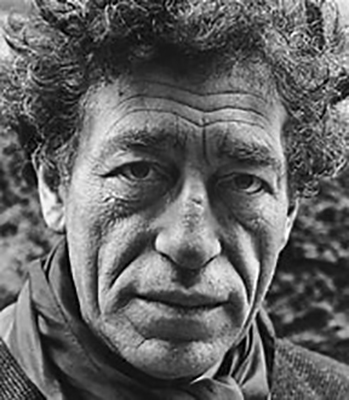ALBERTO GIACOMETTI (1901-1966)
 Alberto Giacometti was born in 1901 in a small village in Switzerland near the Italian border. His father, Giovanni Giacometti, was a well-known artist who taught his young son the basics of painting. In 1919, Alberto moved to Geneva to continue his studies, and then in 1922 he went to Paris where he trained under the sculptor Antoine Bourdelle, an associate of Auguste Rodin. Giacometti became widely acclaimed as a preeminent surrealist sculptor, although he continued to devote time to painting and drawing. He lived in Geneva during World War II, but returned to Paris in 1945 where he remained until his death in 1966. Awarded many prizes during his lifetime, including the Carnegie Prize in 1961, the Grand Prix at the Venice Biennale in 1962 and the Guggenheim Prize for painting in 1964, Giacommetti is today regarded as one of the most exceptional and evocative artists of the mid-20th century.
Alberto Giacometti was born in 1901 in a small village in Switzerland near the Italian border. His father, Giovanni Giacometti, was a well-known artist who taught his young son the basics of painting. In 1919, Alberto moved to Geneva to continue his studies, and then in 1922 he went to Paris where he trained under the sculptor Antoine Bourdelle, an associate of Auguste Rodin. Giacometti became widely acclaimed as a preeminent surrealist sculptor, although he continued to devote time to painting and drawing. He lived in Geneva during World War II, but returned to Paris in 1945 where he remained until his death in 1966. Awarded many prizes during his lifetime, including the Carnegie Prize in 1961, the Grand Prix at the Venice Biennale in 1962 and the Guggenheim Prize for painting in 1964, Giacommetti is today regarded as one of the most exceptional and evocative artists of the mid-20th century.
Giacometti’s work is extensive and covers many different media. Stylistically, he was influenced by the surrealism of Joan Miró and Max Ernst, the cubism of Pablo Picasso and the distorted realism of Balthus. He is best known for his bronze sculptures of elongated, human figures. In these sculptures, Giacommeti lengthened the human form until he was left with an emaciated shadow of the original body. These sculptures seem to convey a psychological commentary on the relationship of people to their surroundings: human beings become whittled down to mere fragments in the face of forces beyond their control. Giacommetti’s sculptures speak to a kind of spiritual depravity of modern times.
Works in other media likewise focus on the human figure in different contexts. In his drawings, he often depicts figures emerging out of a sea of straight and curving lines. This meshing of lines, often in black or blue ink continues the dialogue between human beings and their environment. It is as if the figure emerges from a background of chaotic and hostile markings that dare to usurp it. At the same time, the figure derives its being from those very swirls and jutting zigzags. The background and figure are part of the same compositional material and the relationship between the two aspects of the drawing becomes blurred. Giacometti reveals his artistic creativity in these psychologically complex pieces.
